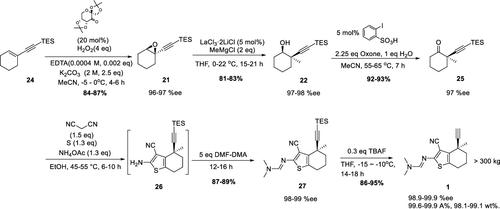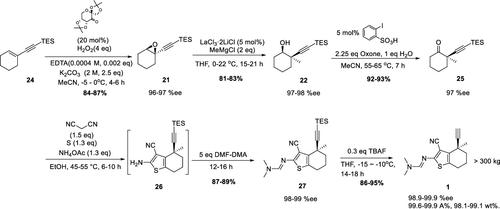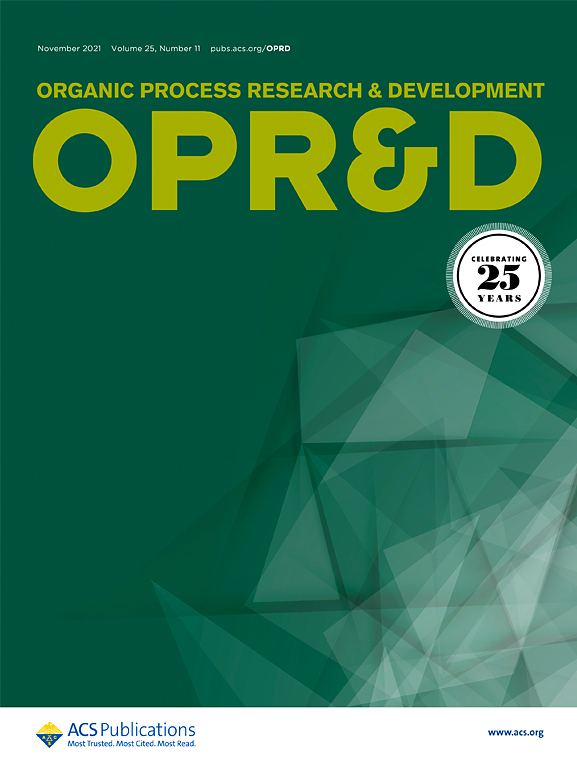开发具有全碳季立体中心的 KRAS G12C 抑制剂构筑基块的可扩展合成方法,第 2 部分:通过施环氧化进行不对称合成
IF 3.1
3区 化学
Q2 CHEMISTRY, APPLIED
引用次数: 0
摘要
本文介绍了一种可扩展的 KRAS G12C 抑制剂结构单元 1 的不对称合成方法。全碳四元立体中心是通过 Shi 环氧化反应进行对映选择性安装的,随后是新发现的区域选择性 LaCl3-2LiCl 催化环氧化物开放。随后的有机催化氧化提供了所需的酮,酮进行了杂环核心的最终组装,仅用五个步骤就得到了化学纯度和对映体纯度都很高的 1,总收率为 40%,从而能够稳健而快速地制造出超过 300 公斤的 1。本文章由计算机程序翻译,如有差异,请以英文原文为准。


Development of a Scalable Synthesis toward a KRAS G12C Inhibitor Building Block Bearing an All-Carbon Quaternary Stereocenter, Part 2: Asymmetric Synthesis via Shi Epoxidation
The development of a scalable asymmetric synthesis of KRAS G12C inhibitor building block 1 is described. The all-carbon quaternary stereocenter was installed enantioselectively via Shi epoxidation, followed by a newly discovered regioselective LaCl3·2LiCl-catalyzed epoxide opening. Subsequent organocatalyzed oxidation provided the requisite ketone, which underwent the final assembly of the heterocyclic core, delivering 1 with high chemical and enantiomeric purities in 40% overall yield in only five steps, enabling robust and rapid manufacturing of over 300 kg of 1.
求助全文
通过发布文献求助,成功后即可免费获取论文全文。
去求助
来源期刊
CiteScore
6.90
自引率
14.70%
发文量
251
审稿时长
2 months
期刊介绍:
The journal Organic Process Research & Development serves as a communication tool between industrial chemists and chemists working in universities and research institutes. As such, it reports original work from the broad field of industrial process chemistry but also presents academic results that are relevant, or potentially relevant, to industrial applications. Process chemistry is the science that enables the safe, environmentally benign and ultimately economical manufacturing of organic compounds that are required in larger amounts to help address the needs of society. Consequently, the Journal encompasses every aspect of organic chemistry, including all aspects of catalysis, synthetic methodology development and synthetic strategy exploration, but also includes aspects from analytical and solid-state chemistry and chemical engineering, such as work-up tools,process safety, or flow-chemistry. The goal of development and optimization of chemical reactions and processes is their transfer to a larger scale; original work describing such studies and the actual implementation on scale is highly relevant to the journal. However, studies on new developments from either industry, research institutes or academia that have not yet been demonstrated on scale, but where an industrial utility can be expected and where the study has addressed important prerequisites for a scale-up and has given confidence into the reliability and practicality of the chemistry, also serve the mission of OPR&D as a communication tool between the different contributors to the field.

 求助内容:
求助内容: 应助结果提醒方式:
应助结果提醒方式:


